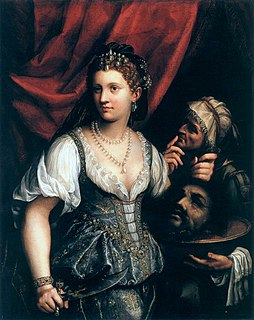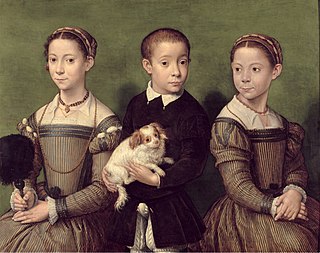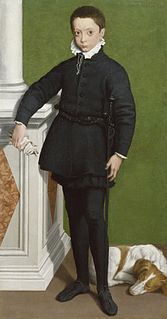
Sofonisba Anguissola, also known as Sophonisba Angussola or Sophonisba Anguisciola, was an Italian Renaissance painter born in Cremona to a relatively poor noble family. She received a well-rounded education that included the fine arts, and her apprenticeship with local painters set a precedent for women to be accepted as students of art. As a young woman, Anguissola traveled to Rome where she was introduced to Michelangelo, who immediately recognized her talent, and to Milan, where she painted the Duke of Alba. The Spanish queen, Elizabeth of Valois, was a keen amateur painter and in 1559 Anguissola was recruited to go to Madrid as her tutor, with the rank of lady-in-waiting. She later became an official court painter to the king, Philip II, and adapted her style to the more formal requirements of official portraits for the Spanish court. After the queen's death, Philip helped arrange an aristocratic marriage for her. She moved to Sicily, and later Pisa and Genoa, where she continued to practice as a leading portrait painter.

Lavinia Fontana was a Bolognese Mannerist painter active in Bologna and Rome. She is best known for her successful portraiture, but also worked in the genres of mythology and religious painting. She was trained by her father Prospero Fontana who was a teacher at the School of Bologna. She is regarded as the first female career artist in Western Europe as she relied on commissions for her income. Her family relied on her career as a painter, and her husband served as her agent and raised their 11 children. She was perhaps the first woman artist to paint female nudes, but this is a topic of controversy among art historians.

Boy Bitten by a Lizard is a painting by the Italian Baroque painter Caravaggio. It exists in two versions, both believed to be authentic works of Caravaggio, one in the Fondazione Roberto Longhi in Florence, the other in the National Gallery, London.

Lucia Anguissola was an Italian Mannerist painter of the late Renaissance. Born in Cremona, Italy, she was the third daughter among the seven children of Amilcare Anguissola and Bianca Ponzoni. Her father was a member of the Genoese minor nobility and encouraged his five daughters to develop artistic skills alongside their humanist education. Lucia most likely trained with her renowned eldest sister Sofonisba Anguissola. Her paintings, mainly portraits, are similar in style and technique to those of her sister. Contemporary critics considered her skill exemplary; according to seventeenth-century biographer Filippo Baldinucci, Lucia had the potential to "become a better artist than even Sofonisba" had she not died so young.

A self-portrait is a representation of an artist that is drawn, painted, photographed, or sculpted by that artist. Although self-portraits have been made since the earliest times, it is not until the Early Renaissance in the mid-15th century that artists can be frequently identified depicting themselves as either the main subject, or as important characters in their work. With better and cheaper mirrors, and the advent of the panel portrait, many painters, sculptors and printmakers tried some form of self-portraiture. Portrait of a Man in a Turban by Jan van Eyck of 1433 may well be the earliest known panel self-portrait. He painted a separate portrait of his wife, and he belonged to the social group that had begun to commission portraits, already more common among wealthy Netherlanders than south of the Alps. The genre is venerable, but not until the Renaissance, with increased wealth and interest in the individual as a subject, did it become truly popular.

Fede Galizia, better known as Galizia, was an Italian Renaissance painter of still-lifes, portraits, and religious pictures. She is especially noted as a painter of still-lifes of fruit, a genre in which she was one of the earliest practitioners in European art. She is perhaps not as well known as other female artists, such as Angelica Kauffman and Elizabeth Vigée-Lebrun, because she did not have access to court-oriented or aristocratic social circles, nor had she sought the particular patronage of political rulers and noblemen.

Barbara Longhi was an Italian painter. She was much admired in her lifetime as a portraitist, although most of her portraits are now lost or unattributed. Her work, such as her many Madonna and Child paintings, earned her a fine reputation as an artist.

Self-portrait by Judith Leyster is an Dutch Golden Age painting in oils now in the collection of the National Gallery of Art in Washington DC. It was offered in 1633 as a masterpiece to the Haarlem Guild of St. Luke. It was attributed for centuries to Frans Hals and was only properly attributed to Judith Leyster upon acquisition by the museum in 1949. The style is indeed comparable to that of Hals, Haarlem's most famous portraitist.

Portrait of the Artist's Family is a 1558–59 oil on canvas painting by the Italian artist Sofonisba Anguissola in the Nivaagaard art gallery.

Elena Anguissola was an Italian painter and nun. She was the sister of the better-known painter Sofonisba Anguissola.

Lady in a Fur Wrap is an oil painting now generally attributed to Alonso Sánchez Coello, dated to 1577-1579 and now held at the Pollok House in Glasgow.

The Portrait of Elena Anguissola, dated to 1551, is one of the earliest paintings by Sofonisba Anguissola. It hangs in the Southampton City Art Gallery.

The Child Bitten by A Lobster is a drawing by Sofonisba Anguissola, executed in chalk and pencil on light blue paper, and dated to around 1554. It is in the collection of the Museo di Capodimonte, in Naples.

The Game of Chess is an oil on canvas painting by Italian Renaissance artist Sofonisba Anguissola from 1555. Anguissola was 23 years old when she painted it.

Anna Maria Anguissola was a 16th-century Italian painter born in Cremona, Italy.

Self-Portrait is a small oil on panel painting by Sofonisba Anguissola, signed and dated 1554 on the open book held by the artist. It is now in the Kunsthistorisches Museum in Vienna.

Portrait of Minerva Anguissola is a c. 1564 oil on canvas painting by Sofonisba Anguissola, now in the Pinacoteca di Brera in Milan.

Portrait of Elisabeth of Valois is a c.1561-1565 oil on canvas painting by Sofonisba Anguissola, now in the Museo del Prado in Madrid.

Portrait of Massimiliano II Stampa is a c.1558 oil on canvas painting by Sofonisba Anguissola, now in the Walters Art Museum, Baltimore, USA. It was previously misattributed to Giovan Battista Moroni, possibly due to stylistic similarities with Moroni's The Knight in Black.
Maria Kusche was a Spanish art historian of German descent, a specialist on painters at the royal court of Philip II of Spain, in particular Sofonisba Anguissola, Juan Pantoja de la Cruz, and Alonso Sánchez Coello.


















